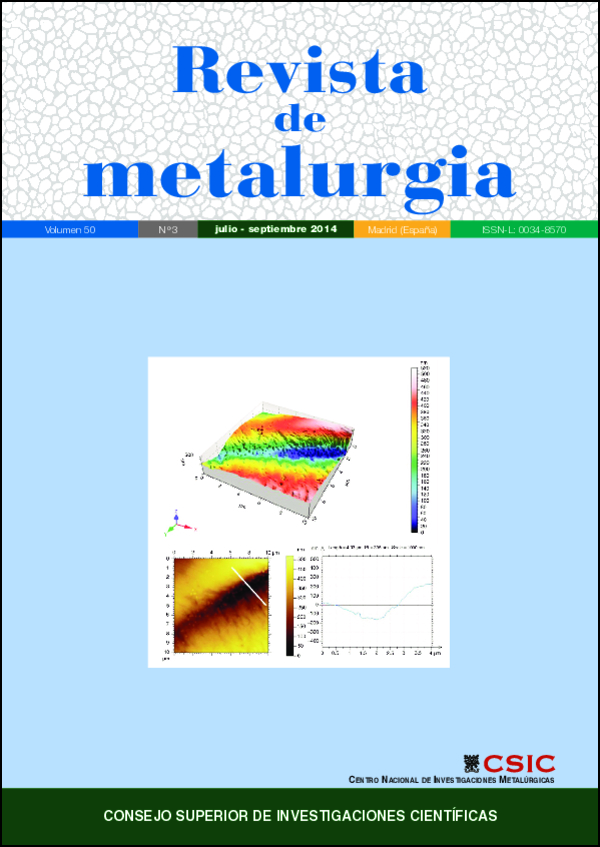On the feasibility of BLISK produced by linear friction welding
DOI:
https://doi.org/10.3989/revmetalm.023Keywords:
Aero-engines, BLISK (Bladed Disk), Demonstrator, Linear Friction Welding (LFW), Titanium alloys (Ti-6246 and Ti-64)Abstract
Friction welding technologies are solid-state processes that convert mechanical energy into heat at the joint to be welded. In the case of linear friction, interatomic diffusion takes place under compressive contact by rubbing one component across the face of the other. It is a relatively recent technology which has found important applications in the aeronautical sector. Specifically, it is applied by world leading aero-engine manufacturers for the fabrication of BLISK, a design where disk and blades are a single component. It is obvious that for such a critical function the reliability of linear friction welds must be totally guaranteed. The present work displays results concerning the characterization, both microstructural and mechanical, of a BLISK demonstrator designed for the intermediate pressure compressor of an aero-engine. Moreover, considering that the design constrains for disks and blades on the compressors are quite different, dissimilar titanium alloys were selected for each part in order to improve the BLISK in-service performance. The results establish that linear friction welding is a reliable process which can produce joints free of defects and with mechanical properties comparable to those of the corresponding base materials.
Downloads
References
Albuquerque, J., Ramos, R.A., Gomes, M.A., Cruz, A.C. (2005). Comportamiento a la fatiga de soldaduras por fricción lineal de AlSi 10 Mg. Rev. Metal. 41 (2), 126–132.
Attallah, M.M., Preuss, M., Bray, S. (2009). Microstructural development during linear friction welding of titanium alloys. Proceedings of the 8th Int. Conf. Trends in Welding Research, Georgia, USA, pp. 486–491.
Bhamji, I., Preuss, M., Threadgill, P.L., Moat, R.J., Addison, A.C., Peel, M.J. (2010). Linear friction welding of AISI 316L stainless steel. Mater. Sci. Eng. A 528 (2), 680–690. http://dx.doi.org/10.1016/j.msea.2010.09.043
Bußmann, M., Kraus, J., Bayer, E. (2005). An Integrated Cost- Effective Approach to Blisk Manufacturing. Proceedings of 17th Symposium on Air Breathing Engines, ISABE, Munich, Germany.
Ceschini, L., Morri, A., Rotundo, F., Jun, T.S., Korsunsky, A.M. (2010). A Study on Similar and Dissimilar Linear Friction Welds of 2024 Al Alloy and 2124Al/SiCP Composite. Adv. Mater. Res. 89–91, 461–466. http://dx.doi.org/10.4028/www.scientific.net/AMR.89-91.461
Corzo, M., Casals, O., Alcala, J., Mateo, A., Anglada, M. (2005). Evaluación mecánica mediante técnicas de indentación de soldaduras por fricción lineal en aleaciones de titanio. Rev. Metal. 41 (6), 403–409. http://dx.doi.org/10.3989/revmetalm.2005.v41.i6.231
Donachie, M.J. (2000). Titanium: A technical guide. ASM International, Ohio, USA.
Esslinger, J. (2003). Proceedings of 10th Titanium World Conference, Lütjering, G., Albrecht, J. (Eds.), Vol. V, Munich, Germany, pp. 2837–2844.
External Advisory Group for Aeronautics of the European Commission (2000). Aeronautics for Europe, Office for Official Publications of the European Communities, Belgium.
Flightglobal website (2014). http://www.flightglobal.com/news/articles/rolls-royce-tests-material-to-give-jsf-engine-somebling-214302/, June 2014.
Kermanpur, A., Sepehri Amin, H., Ziaei-Rad, S., Nourbakhshnia, N., Mosaddeghfar, M. (2008). Failure analysis of Ti6Al4V gas turbine compressor blades. Eng. Fail. Anal. 15 (8), 1052–1064. http://dx.doi.org/10.1016/j.engfailanal.2007.11.018
Lütjering, G., Williams, J.C. (2003). Titanium. Engineering Materials and Processes, Springer-Verlag Berlin Heidelberg, Germany, pp. 224–232. http://dx.doi.org/10.1007/978-3-540-71398-2
Ma, T., Li, W.Y., Quanzhou, X., Zhang, Y., Li, J., Yang, S., Liao, H. (2007). Microstructure evolution and mechanical properties of linear friction welded 45 steel joint. Adv. Eng. Mater. 9 (8), 703–707. http://dx.doi.org/10.1002/adem.200700090
Maalekian, M. (2007). Friction welding critical assessment of literature. Sci. Technol. Weld. Join. 12 (8), 738–759. http://dx.doi.org/10.1179/174329307X249333
Mary, C., Jahazi, M. (2006). Linear Friction Welding of IN-718 Process Optimization and Microstructure Evolution. Adv. Mater. Res. 15–17, 357–362.
McNelley, T.R. (2010). Friction stir processing (FSP): refining microstructures and improving properties. Rev. Metal. 46 (N° Extra), 149–156.
Mohandas, T., Banerjee, D., Kutumba Rao, V.V. (2000). Microstructure and mechanical properties of friction welds of an α + β titanium alloy. Mater. Sci. Eng. A 289 (1–2), 70–82. http://dx.doi.org/10.1016/S0921-5093(00)00914-X
Nicholas, E.D. (2003). Friction processing technologies. Weld. World 47 (11–12), 2–9. http://dx.doi.org/10.1007/BF03266402
Nunn, M.E. (2005). Aero Engine improvements through linear friction welding. Proceedings 1st Int. Conference on Innovation and Integration in Aerospace Sciences, Belfast, Northern Ireland, U.K.
Peters, J.O., Lütjering, G. (2001). Comparison of the fatigue and fracture of a + b and b titanium alloys. Metal. Mater. Trans. A 32 (11), 2805–2818. http://dx.doi.org/10.1007/s11661-001-1031-8
Roder, O., Hem, D., Lütjering, G. (2003). Proceedings of 10th Titanium World Conference, Lütjering, G., Albrecht, J. (Eds.), Vol. V, Munich, Germany, pp. 2867–2874.
Sorina-Mu.ller, J., Rettenmayr, M., Schneedfeld, D., Roder, O., Fried, W. (2010). FEM simulation of the linear friction welding of titanium alloys. Comput. Mater. Sci. 48 (4), 749–758. http://dx.doi.org/10.1016/j.commatsci.2010.03.026
Threadgill, P.L. (2001). Linear friction welding. May be accessed at: http://materialteknologi.hig.no/Lettvektdesign/joining%20methodsjoining-welding-linear%20friction%20welding.htm.
Uday, M.B., Ahmad Fauzi, M.N., Zuhailawati, H., Ismail, A.B. (2010). Advances in friction welding process. Sci. Technol. Weld. Join. 15 (7), 534–558. http://dx.doi.org/10.1179/136217110X12785889550064
Vairis, A., Frost, M. (1999). On extrusion stage of linear friction welding of Ti-6Al-4V. Mater. Sci. Eng. A 271 (1–2), 477–484. http://dx.doi.org/10.1016/S0921-5093(99)00449-9
Wanjara, P., Jahazi, M. (2005). Linear friction welding of Ti-6Al-4V: Processing, microstructure and mechanical property inter-relationships. Metall. Mater. Trans. A 36 (8), 2149–2164. http://dx.doi.org/10.1007/s11661-005-0335-5
Wilhem, H., Furlan, R., Moloney, K.C. (1995). Linear friction bonding of titanium alloys for aeroengine applications, Proceedings of the 8th World Conference on Titanium, Blenkinsop, P.A. et al., (Eds.), Birmingham, U.K., pp. 620–626
Published
How to Cite
Issue
Section
License
Copyright (c) 2014 Consejo Superior de Investigaciones Científicas (CSIC)

This work is licensed under a Creative Commons Attribution 4.0 International License.
© CSIC. Manuscripts published in both the printed and online versions of this Journal are the property of Consejo Superior de Investigaciones Científicas, and quoting this source is a requirement for any partial or full reproduction.
All contents of this electronic edition, except where otherwise noted, are distributed under a “Creative Commons Attribution 4.0 International” (CC BY 4.0) License. You may read the basic information and the legal text of the license. The indication of the CC BY 4.0 License must be expressly stated in this way when necessary.
Self-archiving in repositories, personal webpages or similar, of any version other than the published by the Editor, is not allowed.
















